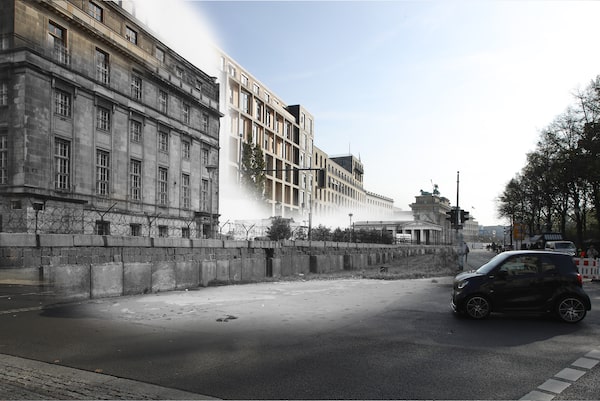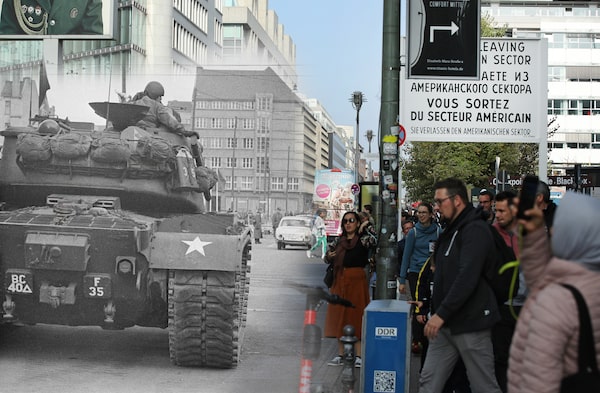
This digital composite image shows Leuschnerdamm street in Berlin in 1963 and on Oct. 23, 2019.Express Newspapers/Getty Images
Nov. 9, 2019, marks the 30th anniversary of the fall of the Berlin Wall: the night the concrete symbol of a divided country, a divided Europe and a world divided by Cold War hostilities, opened its gates to allow East Germans into the island of West Berlin. For some who had been born since communist East Germany (or the German Democratic Republic) constructed the wall in 1961, it was their first time in the West. For others, it was a chance at reunion and first meetings after decades of separation. For a Germany split by the Allied powers at the end of the Second World War, it was the end of the Soviet satellite state defined by the terror of its secret police, the Stasi, and the beginning of a new country, the Berlin Republic of today.
Many popular histories misinterpret the fall of the Wall as a self-evident conclusion to a clash of Cold War ideologies. Certainly the situation in East Germany in November, 1989 was untenable. Yet, as historian Mary Elise Sarotte describes in The Collapse: The Accidental Opening of the Berlin Wall (Basic Books, 292 pages), no one in the East German government, not even those whose actions catalyzed the events of Nov. 9, saw it coming. And on the very day East Germans would flood across checkpoints into West Berlin, the West German chancellor, Helmut Kohl, remarked he didn’t expect the Wall to open any time soon. How did the communist dictatorship crumble so swift and peaceably – unlike the violence in Romania later that year? Sarotte’s behind-the-scenes history attributes this peaceful revolution to proximate causes: the courage of everyday East Germans, miscommunication between bureaucrats and a scary amount of pure luck.
The extent of what East Germans were up against only became clear after the Wall’s fall. The Stasi’s web of 174,000 “unofficial collaborators” – informants on their fellow citizens – made East Germans, by some estimates, the most heavily surveilled population in human history. Spouse, parent, sibling, student, teacher, doctor, friend: No human bond was too sacred (though those of us who have never lived under such pressures can hardly judge) – a fact that became apparent when unified Germany passed a law making Stasi files available to those spied upon. In his 1997 memoir-of-sorts, The File (Vintage, 256 pages), Timothy Garton Ash revisits his life in West and East Berlin in the late 1970s to early 80s through the file the Stasi kept on him. As a British citizen working in the East, the consequences for Ash of being informed upon were mild – he got thrown out of the country – but dire for the friends he left behind. When Ash confronts those who pointed the finger at him as well as the Stasi officers responsible for his file, his purpose is not accusation, however, but a desire to understand how such a system worked.

Here we see Scheidemannstrasse near the Brandenburg Gate in Berlin in 1966 and on Oct. 23, 2019.John Waterman/Getty Images
In the months after the Wall fell, it was not obvious what would come next, whether the two Germanies would unify, or if, as many East German activists hoped, the GDR would remain socialist but democratized, with greater freedoms. Among the German novelists who emerged in the 1990s as chroniclers of the new Germany, Ingo Schulze has made the transition of former East Germans, their paired exhilaration and disillusionment with the West, his prolonged subject. Among his books (Simple Stories, Adam and Evelyn, One More Story) the best example of this transmutation is in his 2005 novel New Lives (Knopf, 570 pages), translated by John E. Woods, a Faustian story about a former dramaturge in the East German town of Altenburg (near Leipzig), who transforms into that creature of the West: a businessman.

Finally, Checkpoint Charlie in Berlin is seen in February, 1961, contrasted with Berlin on Oct. 23, 2019.Express Newspapers/Getty Images
Three culture vultures tell us what we need to read
The Wall Jumper, by Peter Schneider, translated by Leigh Hafrey
“When I lived in Stuttgart back in 2006, my German teacher introduced me to the expression mauerkopf – which literally translates as ‘wall-head.’ For her, the phrase conveyed a certain lack of sophistication, a perplexing insistence on continuing to live all these years later as if the Berlin Wall was still intact. It was, in a sense, a kind of grievance against those who refused her vision of what a free life should be. But it set me thinking about the ways in which a wall is almost always more than a wall – the way it extends beyond concrete and steel to lodge in the mind as an ideal, a barrier, a ghost. Peter Schneider’s charming 1989 novel The Wall Jumper is alive with all these resonances. It is an unorthodox book, and a funny one, following the adventures of those who either attempt to or succeed in overcoming the Wall. But it is a serious read, too, one that, beyond Cold War ideologies, offers sharp insights about what it means to live divided from one’s nation, one’s family, oneself.”
Esi Edugyan is the author of the Giller Prize–winning novels Washington Black and Half-Blood Blues, the latter inspired during her residency in Stuttgart.
What Remains and Other Stories, by Christa Wolf, translated by Heike Schwarzbauer and Rick Takvorian
“For me Christa Wolf and her works represent the ambivalence of the GDR times. Wolf has been a controversial figure: a celebrated author in both East and West Germany, a firm believer in socialism, by some regarded as a dissident writer, while criticized by others for not distancing herself from the authoritarian regime. The title story, What Remains, depicts a day in the life of a female writer who is openly kept under surveillance by the secret police. With Wolf herself knowing both perspectives – surveillant and surveyed – the publication of the novella in 1990 triggered the ‘Literaturstreit,’ a wide debate about East and West German literature, leftist intellectual positions and literary concepts.”
Katja Melzer is director of the Goethe-Institut Montreal, which hosts a series of exhibits and film screenings commemorating the 30th anniversary, including The Wall – A Border Through Germany, until Nov.r 29. goethe.de/montreal
Go, Went, Gone, by Jenny Erpenbeck, translated by Susan Bernofsky
“Today’s Germany has its birthplace in that year of transformation – 1989-90 – but also in the protracted and often painful process of social and cultural transformation in the 30 years since. For a snapshot of Germany now, I recommend Jenny Erpenbeck’s brilliant novel, Go, Went, Gone, set in the year of the ‘refugee crisis’ in 2015, when over one million refugees started their lives in Germany. At the novel’s centre is a recently retired German classics professor, Richard, who befriends a group of refugees. These men of radically different backgrounds are all trapped in Germany’s cumbersome bureaucratic system, which allows them temporarily stay but does not allow them to work. The humanism of Erpenbeck’s view of German society contrasts with her incisive critique of the German state. There are many ways to be German, this novel says. Richard himself is a former East German [as is the author], and he often reflects on his own process of unlearning a former way of ‘being German’ in adapting to a new one.”
Jennifer Jenkins is associate professor of German and European History at the University of Toronto and former Canada Research Chair for Modern German History (2004–2014)
Expand your mind and build your reading list with the Books newsletter. Sign up today.